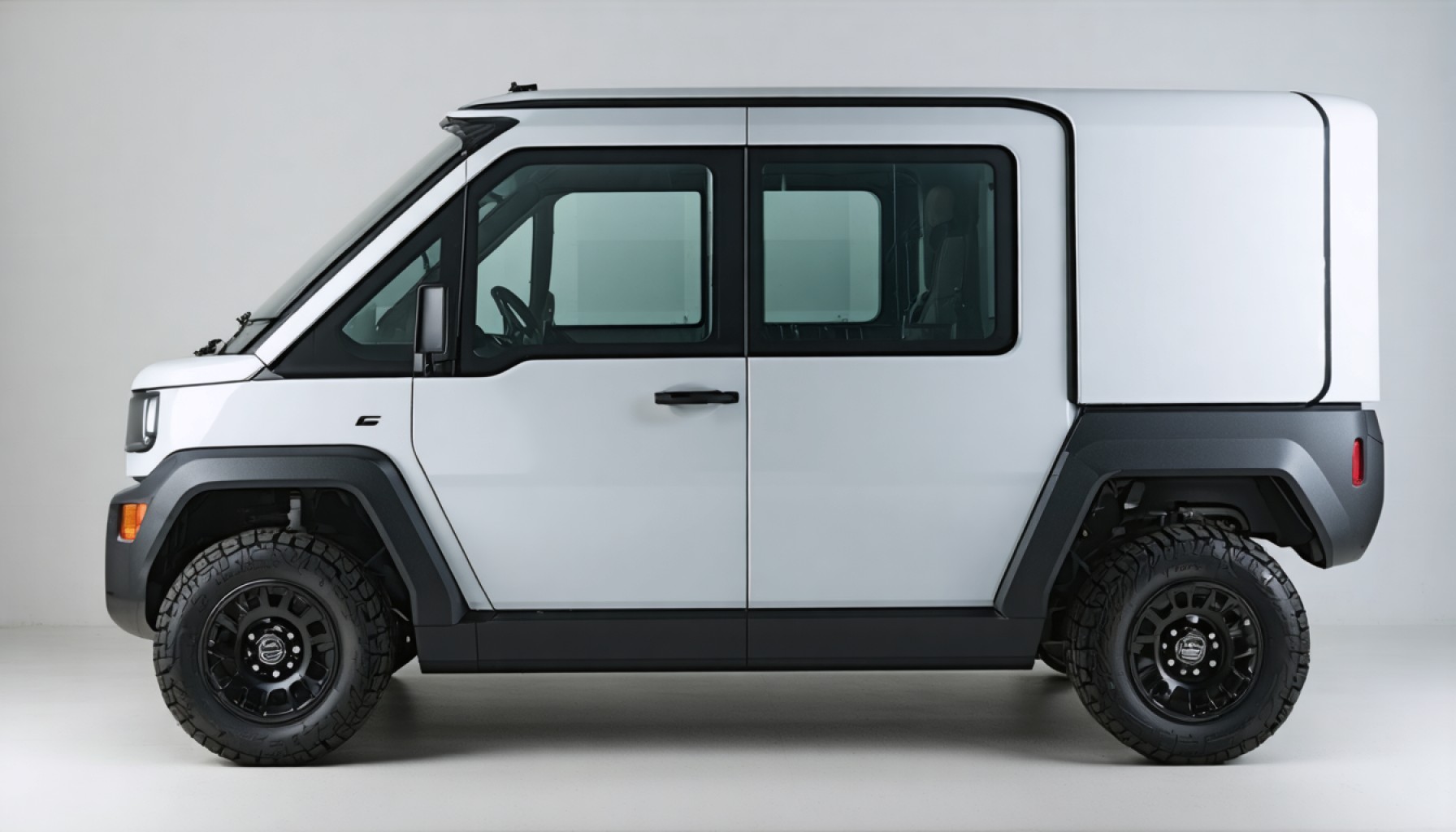
- The Slate Truck targets affordability in the electric vehicle market, with a base price between $20,000 to $25,000.
- The truck embraces simplicity over technology, featuring manual windows and smartphone-powered stereo systems, while still prioritizing safety with forward collision warnings.
- It offers two battery options: a 57.2 kWh version with a 150-mile range and an 84.3 kWh option extending the range to 240 miles.
- Charging is efficient with an NACS port, allowing an 80% charge in under 30 minutes.
- The vehicle’s performance is modest, focusing on utility with a top speed of 90 mph and 0 to 60 mph acceleration in eight seconds.
- Slate Auto plans to revitalize American manufacturing with a new factory in the Midwest, despite potential obstacles such as tariffs and political challenges.
- The Slate Truck represents a shift toward accessible, no-frills electric transportation, aligning with broader sustainability goals.
Amidst the ever-growing realm of electric vehicles (EVs), where flashy dashboards and cutting-edge technology reign, a scrappy startup backed by Jeff Bezos is plotting a bold, simplistic course. Enter the Slate Truck—an electric pickup that shuns the glitz for stripped-down practicality, with a tantalizing base price of just $20,000 to $25,000.
Picture a vehicle that stands in stark contrast to today’s technology-laden EV offerings. The Slate Truck, at its core, rejects the allure of touchscreens and digital assistants. Windows that you crank? Check. A stereo system powered by your trusty smartphone? Absolutely. The truck shrugs off features many take for granted, yet still prioritizes safety. Imagine cruising with peace of mind, thanks to forward collision warnings and a potential five-star crash rating.
Beneath the minimalistic exterior lies a heart of cutting-edge engineering. A 57.2 kWh battery propels the base model, granting it a modest 150-mile range. Drivers seeking more mileage can opt for an 84.3 kWh variant, pushing the range to 240 miles. Thanks to the inclusion of an NACS charging port, you’re promised a quick recovery to 80% charge in less than half an hour.
Where speed is concerned, the Slate Truck prefers steady over spectacular, accelerating from 0 to 60 mph in eight seconds and reaching a top speed of 90 mph. These figures nod to its utilitarian ethos—speed takes a backseat to purpose and accessibility.
The Slate Truck’s roll-out hints at a potential renaissance in American manufacturing, with plans for a factory in reindustrialized Midwest locations. But looming over these aspirations are challenging tariffs and political headwinds that could impact everything from motors to battery components.
The Slate Truck emerges not merely as a vehicle but a symbol of the potential shift toward more affordable, no-frills electric driving. By trading luxury for practicality, Slate Auto aims to offer a pathway for many to embrace the electric future without breaking the bank. As the world pivots toward sustainability, this humble truck dares to suggest that sometimes, less truly is more.
Simplified Elegance: The Slate Truck Challenges Modern EV Norms
Introduction
In a landscape dominated by high-tech innovation, the Slate Truck is a breath of fresh air, offering a minimalist alternative in the electric vehicle (EV) market. It stands out for its utilitarian design, backed by notable investor Jeff Bezos. But how does the Slate Truck truly measure up? Let’s dive into its features, advantages, and the broader impact it may have on the EV industry.
Features & Specifications
– Price Point: With a starting price of $20,000 to $25,000, the Slate Truck enters the market as one of the most affordable EV options available. This price undercuts many competitors, making it accessible to a wider audience.
– Battery Options: The base model features a 57.2 kWh battery, offering about 150 miles of range. A more robust 84.3 kWh battery is available, extending the range to approximately 240 miles.
– Charging and Compatibility: The inclusion of a North American Charging Standard (NACS) port enables the battery to recharge up to 80% in under 30 minutes, providing convenience for quick stops.
– Design Aesthetics: Eschewing luxury for simplicity, the truck features manual crank windows and relies on smartphone connectivity for the stereo system, reducing points of failure and lowering costs.
– Performance: Acceleration from 0-60 mph occurs in eight seconds, with a top speed capped at 90 mph. This underlines its focus on practicality over speed.
– Safety: Despite the simplified design, the truck includes key safety features like forward collision warnings and aims for a five-star crash rating.
Market Forecasts & Industry Trends
– Target Audience: The Slate Truck is ideal for first-time EV buyers or those seeking an economical and sustainable vehicle option for daily use.
– Manufacturing Potential: Plans for a manufacturing facility in the Midwest could revitalize American manufacturing and reduce dependency on overseas production—an appealing prospect amid current geopolitical tensions.
– Economic Challenges: Potential tariffs and trade policies might affect the cost and availability of components, impacting overall manufacturing plans.
Pros and Cons Overview
Pros:
– Affordable pricing broadens market access.
– Simplified design minimizes failure points and maintenance costs.
– Quick charging enhances convenience.
– Environmentally friendly foot forward with an accessible EV option.
Cons:
– Limited range compared to other EVs in its segment.
– Basic interior may not appeal to tech-savvy consumers.
– Potential manufacturing and tariff hurdles.
Real-World Use Cases
– Rural and Suburban Usage: Ideal for short commutes and daily tasks in rural and suburban areas, where EV infrastructure is developing.
– Fleet Vehicles: Companies seeking to transition to electric fleets may find the Slate Truck a cost-effective and reliable choice.
– Utility and Construction: Its no-frills design makes it suitable for job sites that demand durability over luxury.
Expert Opinions and Predictions
Industry experts recognize the Slate Truck’s potential to disrupt the market by offering a straightforward, reliable EV at a competitive price point. Analysts foresee a shift towards value-driven EVs as consumers prioritize cost and functionality over luxury, potentially influencing future EV designs.
Controversies & Limitations
– Market Viability: Concerns about the longevity of minimalist EV designs exist, given the current consumer trend toward more technologically advanced vehicles.
– Sustainability Impact: While promoting lower emissions, manufacturing practices and battery disposal methods remain under scrutiny for their environmental impact.
Actionable Recommendations
– Consider Your Needs: Evaluate your primary vehicle use to determine if the Slate Truck’s range and features align with your lifestyle.
– Explore Government Incentives: Research any available state or federal incentives for purchasing an electric vehicle, which could further reduce the cost.
– Plan Charging Options: Familiarize yourself with local NACS charging networks to ensure accessibility for quick recharges.
For the latest updates, visit Slate Auto and stay informed about their sustainable initiatives and manufacturing developments.
Conclusion
The Slate Truck symbolizes a potential shift in consumer preferences toward practicality and sustainability in the EV market. By offering a low-cost, reliable alternative, it challenges the norm and paves the way for a broader acceptance of electric transportation.



